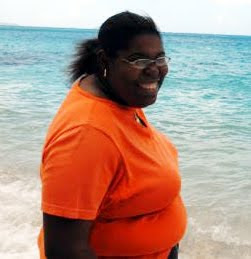
My name is Chela Thomas and I have been working for the National Park Service for a few months now. In this time, I have been trained in the preservation of artifacts from various places on St. John and from an old Yellow Fever hospital and Leprosarium on Hassel Island. My appointed tasks included making bags and tags for the artifacts as well as washing them at times. I am able to catalog the artifacts and verify that everything from the site that I was working with is accounted for and included in the reports.
I grew up on St. John and I recently graduated from the University of the Virgin Islands with a Bachelor of Science in Biology. I have been travelling between St. John and St. Thomas for as long as I can remember, so being able to work with the different artifacts has opened my eyes to the way things were. This is my second summer assisting with artifact preservation and I have come to enjoy it very much. My duties last summer included cataloging the historic photographs and some of the same things as now.
While working on the artifacts form the Leprosarium, I took a particular interest in the bottles fragments. I wanted to know what different types of bottles were used for and how they were made. I learned that most of the bottles I had encountered were used for medicine or alcohol. As I cataloged artifacts from other sites, my interest grew from just bottles to glass in general. I wanted to know how the different types of glass got their distinct colors. My interest in glass got me into trying to analyze different types of finishes and trying to guess what the bottles would have been used for. While most glass is undiagnostic, there are some bottles and maker’s marks that have specific date ranges attached to them.
In addition to glass, I recently have gained an interest in different types of ceramics including porcelain and shell edged wares. The variety they contain is amazing. Each pattern has a different date range but they tend to overlap in certain cases. Some of these ceramics are still in production today and even though they are mass produced, they look the same as they did when they were first being made.
 Finally, due to my background in science, I was asked to assist Susanna in the conservation of archeological metals. This involves the use of chemical indicators and titration to determine the level of chlorides still present in the metals. We are trying to look at the chloride levels on a monthly basis and just received funding to improve our conservation set-up with new tanks and more sodium carbonate.
Finally, due to my background in science, I was asked to assist Susanna in the conservation of archeological metals. This involves the use of chemical indicators and titration to determine the level of chlorides still present in the metals. We are trying to look at the chloride levels on a monthly basis and just received funding to improve our conservation set-up with new tanks and more sodium carbonate. On the whole, I feel that my experience here has deepened my appreciation for the islands and I hope that I can continue my work here.




